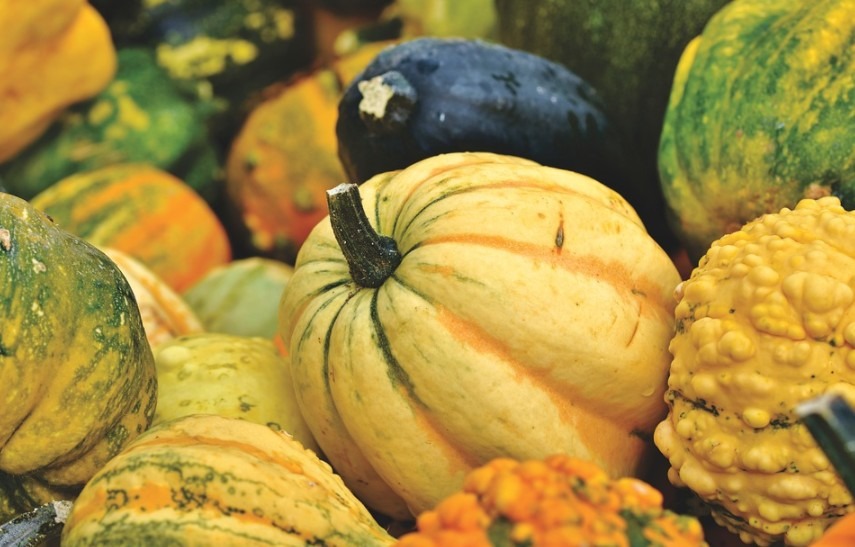Pumpkins are the most famous of all winter squashes. They are plump and highly nutritious orange gourds. Pumpkin is low in calories, but rich in vitamins and minerals. Its flesh is inedible, but its pulp and seeds are extremely wholesome. Many people think of it only as a Halloween decoration or a Thanksgiving pie filling, and don’t consider it to be extremely healthy. But their benefits go beyond decoration and treats.
Nutrition Basics
Pumpkin is commonly viewed as a vegetable, but it is scientifically a fruit. Despite that, its nutritious values are more similar to vegetables. Pumpkins are rich in carbohydrates, fibers, proteins, vitamin A, vitamin B2, vitamin C, vitamin E, potassium, manganese, iron, zinc, and antioxidants like beta-carotene. It is also 94% water and very delicious.
This wide range of nutrients packs a lot of health benefits. To know more about the true potential of the range of benefits that pumpkin has to offer, check out our article on A Guide to the Types and Health Benefits of Pumpkins.
Fiber Content in Pumpkin
If you are a fiber-rich diet enthusiast, this article might assist you in how to get the maximum dietary fiber intake from pumpkins. Do keep on reading till the end for some indulgent high-fiber cooking suggestions.
Pumpkins are a good source of fiber. Fresh pumpkins provide about 0.5 grams of dietary fiber per 100 grams, which makes about 2% of the human body’s daily requirements. Pumpkins are said to provide less fiber than most other kinds of winter squash, because of their high water content. But there are ways you can increase the fiber content of pumpkins.
1. Fresh Pumpkin
A cup of freshly cooked pulp and flesh of pumpkins provides about 50 calories and 3 grams of fiber. This makes up about 12% of the daily intake (according to 2000-calories intake). Fresh pumpkin can be considered a good source of fiber because a serving of 1 cup provides more than 2.7 grams or 11% of the daily value of fiber. Healthy fiber intake from fresh pumpkins gives major health benefits.
Most winter squashes are rich in soluble fibers. Soluble fibers dissolve in the presence of liquid and form a highly viscous gel-like substance. Pumpkins are rich in soluble fibers as well and delay gastric emptying. This helps maintain regularity, feeling of fullness, and controls blood sugar. Soluble fibers have a bunch of other benefits as well, such as lowering cholesterol levels.
2. Pumpkin Seeds
Whole pumpkin seeds are an excellent source of dietary fibers. Shelled pumpkin seeds provide about 1.1 grams of fiber in a single 28-gram serving. Pumpkin seeds are very cheap and easily available. They can be easily incorporated into our daily diets, and also make up for a healthy snack that won’t make you gain any extra pounds.
Diets that are high in fiber are linked with many chronic health benefits, including reduced risk of heart diseases and obesity, etc.
3. Canned Pumpkin
When pumpkins are in their peak season, they are picked and preserved in the form of canned pumpkins. Canned pumpkins are more concentrated in volume; however, the fiber content greatly varies in fresh pumpkins. Canned pumpkins are manufactured by cooking down fresh pumpkin pulp to just the right consistency.
Canned pumpkins without salt are also packed with nutrients and are a better source of dietary fiber when compared to fresh pumpkins. A cup of plain canned pumpkin provides about 7 grams of fiber, which is approximately 28% of the daily value. A single can of pumpkins has a total of 83 calories and qualifies as a high-fiber food because one serving provides more than 20% of the daily value of fiber.
It is available all year round and is best for making pumpkin pie and other baked goods. It is higher in calories than fresh pumpkin; it is also rich in vitamin A and iron.
Cooking Suggestions
Pumpkin has a wide range of culinary applications. It is a huge part of classic fall-centric delicacies. Pumpkin is a very versatile fruit; it goes well with everything from sweet to savory. Despite the traditional pie, here are a variety of recipes you can make all year round using pumpkins.
Canned pumpkin is high in fiber and very convenient. The naturally sweet puree can be used to make smoothie bowls, pizza toppings, salad dressings, and pasta sauces. You can pair these up with more fiber-rich ingredients to up your daily fiber intake.
Fresh or canned pumpkin can also be used to make a variety of baked goods such as muffins, brownies, cakes, or bread. The fiber content in these baked goods increases due to the combination of flour and pumpkins.
Small pumpkins are sweeter as compared to larger ones. Bake and boil down your pumpkin with the flesh removed. After it is cool enough to handle, puree it and use it for mashed potatoes, soups, stews, and gravies.
Roast pumpkin seeds at home in the oven and season it using your favorite spices. This makes a great high-fiber snack or can even be used to make granola.
Moreover, there are many complementary ingredients and spices that go with pumpkin.
Daily Intake Guidelines
Daily values of fiber intake suggest that all individuals should get about 14 grams of fiber for every 1000 calories consumed. Younger adults or adults require more amount of fiber than older individuals because of their low energy requirements.
Final Words
Pumpkin is a powerhouse of nutrition and is rich in all essential nutrients, minerals, and vitamins. It is an ideal food for boosting your daily fiber consumption. Canned pumpkins provide more fiber than fresh pumpkins, but it is best to avoid canned pumpkins with salt to maintain a low sodium diet.
The best thing about pumpkins is that there are many ways you can incorporate them into your diet to increase fiber intake.

